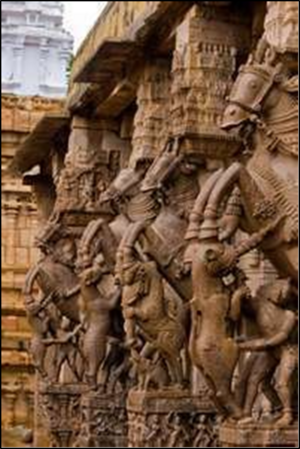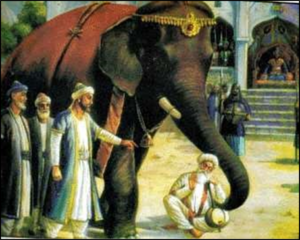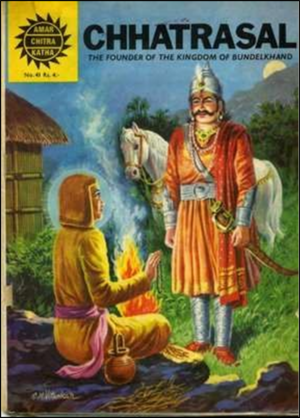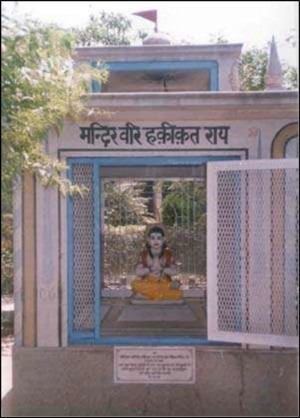Talk:Nirbhaya - The Bhakta Yogī does not Fear Anything
By Vishal Agarwal
A devotee who keeps up constant remembrance of the Lord through the recital and contemplation of His excellences is never agitated and overcome by fear even at the time of death. Bhāgavata Purāṇa 1.18.4 He who saying even once, “Lord I am thine,” expresses the desire to surrender to Me, I make him free of fear from all beings – this is My vow. Rāmāyaṇa 6.18.33
The Dancer of Srirangam Mandir
Ghiyas-ud-din Tughlaq, the Sultan of Delhi, deputed his eldest son Ulugh Khan to invade the Hindu kingdoms of South India in 1321 C.E. When the Muslim army of Ulugh Khan was close to the Srirangam temple, a festival was being conducted. When the invaders reached a place called Samayapuram, a senior official of the temple, decided that no time was to be lost. He requested the 12000 ascetics who had gathered there not to disperse and instead form a human wall to stop the army. Then, he locked the doors of the main worship chamber, barred the doorways of the shrines of both Vishnu and Lakshmi, and placed fake images outside. The invading army desecrated the shrine, killed all the 12000 unarmed ascetics. In the meantime, some temple officials gained enough time to take important articles from the temple to safe places. The Muslim army occupied the temple and put and an end to Hindu worship. A temple dancer, who fascinated the invading general, persuaded him not to destroy the temple altogether, and restrict his vandalism to the destruction of a few minor parts of the temple. The Brahmins in the surrounding areas tried to perform the sacred rituals whenever they could, but were harassed by the occupying Muslim forces constantly. Unable to bear the harassment of the devotees by the Muslims, she enticed the Muslim chief, took him up a temple tower in the east, and in the pretext of showing him a famous Mūrti from there, she pushed him down and killed him.
Scared that she will be tortured by the Muslims as a result of her deed, she threw herself also down and committed suicide. According to tradition, to honor her memory, the funeral pyres of temple dancers were henceforth lit by fire brought from the temple kitchen. In 1371 C.E., the newly founded Hindu kingdom of Vijayanagar wrested back Srirangam from Muslim control, but it was the bravery of the courtesan and the 12,000 defenseless ascetics that had saved the Mandir from total destruction.
Namadeva’s Faith in Dharm
The Saint was once forced to convert to Islam by the Muslim ruler Muhammad bin Tughlaq (1325 – 51 CE), who had invaded the area in which Namadeva lived. Namadeva was ordered to chant Islamic prayers, instead of saying the names of Vishnu. But Namadeva would not stop singing the names of Bhagavān Vishnu. The Sultan was greatly enraged. He had a cow slaughtered and brought in front of Namadeva and asked him to bring back the cow to life, or risk his own throat get slit. Namadeva protested and said that no one can bring a dead creature back to life. The Sultan got infuriated and had a mad elephant attack Namadeva. But when the elephant hit Namadeva’s forehead with its trunk, it felt a great pain instead and fled away from Namadeva. The Saint was miraculously unhurt by the attack of the elephant. But the Sultan would not relent, and had Namadeva tied in chains and tortured. Yet, Namadeva would still not stop singing the names of Lord Vishnu. Namadeva’s mother begged Namadeva to save his life by switching from singing the names of Lord Vishnu to reciting Islamic prayers. But Namadeva would not relent, and stood steadfast in his devotion to Lord Vishnu. After several hours, the chained and tortured Namadeva saw a vision of Lord Vishnu approaching him, seated on the Garuda.
Namadeva asked the Muslim ruler to have the calf of the slaughtered cow to be brought in front of the mother for suckling. The Sultan made fun of Namadeva, and to prove to Namadeva that his faith in Lord Vishnu was useless, he asked the calf to be brought in front of its dead mother anyway. But a miracle happened. As soon as the calf came near, the cow became alive and milk started flowing out of its teats. The slaves of the Sultan filled an entire bucket with the milk and showed it to the Sultan, to prove that Namadeva had brought the cow back to life. The Sultan was terrified when he saw the miracle of Namadeva. He asked Namadeva to forgive him. Namadeva asked the Sultan to give up cruelty and arrogance. All the Hindus gathered around Namadeva and praised him with a sigh of relief, and said that his glory will last forever. Namadeva is considered a Saint not just by Hindus, but also by Sikhs.
King Chhatrasāl (1649 – 1731 CE) and his Guru Mahāmati Prāṇ Nāth (1618 – 1694 CE)
Chhatrasāl (1649 – 1731 CE) is considered as the founder of the Hindu kingdom of Bundelkhand during the reign of the bigoted Muslim ruler Aurangzeb. His kingdom provided one more refuge for non-Muslims in India, and led to the construction of numerous beautiful temples, revival of Hindu religious learning and patronage of Hindu saints. Amazingly, Chhatrasāl started his revolt against the Moghul rule at the age of 22 with the help of just 5 horsemen and 25 soldiers! Chhatrasāl was the son of a Hindu chief Raja Champat Rāi and Rani Lāl Kunwar. He showed great signs of bravery even as a teenager. Once, his entire family was on their way to the Vindhyāvāsinī Devī temple in central India. The 13 year old Chhatrasāl was ahead of his family. When he reached fairly close to the Mandir, he met several Muslim Pathans, who asked him for the location of the Mandir.
Chhatrasāl asked, “Have you come to get a Darshan of the Devi?” The Pathans laughed, “What a fool! We have come to destroy the temple and break the Mūrti worshipped by you Hindus.” Chhatrasāl became very angry and challenged them to a fight. The Pathans mocked him saying, “You are but a teenager. Better scamper off and save your life.” But Chhatrasāl could not be scared. A sword fight ensued, and the 13 year old Chhatrasāl single handedly killed all the Pathans. His act of bravery saved the Hindu mandir from destruction. When Chhatrasāl grew up, he decided to stop Aurangzeb’s policy of religious persecution of Hindus. He found an able guide in a Hindu Sannyasin named Prāṇ Nāth, who was from Gujarat.
Keshava Bhatta, Madhukara Sāha
Numerous anecdotes are related in the Bhaktamāla and Priyadāsa’s commentary thereon that describe the persecution of Hindus under the Muslim rulers. During the reign of Aurangzeb, some of his soldiers tried to kill Kilhadeva (a saintly elder contemporary of Nābhā Goswāmī) while he meditated on the banks of Yamuna in Mathura by driving nails into his skull. Through a miracle, the nails failed to kill him. Later, Kilhadeva went to the court of the ruler and performed a miracle to convince him that forcible conversions of Hindus to Islam were contrary to nature, and that the two faiths were distinct and different. (Priyadāsa’s commentary on text 40 of Bhaktamāla of Nābhā Goswāmī). Close to the Vishrāma Ghāt on the Yamuna in Mathura lived a colony of Muslims who would convert Hindu pilgrims arriving in the area to Islam by kidnapping them and forcibly circumcising them. They would then mock these Hindus, who were deeply embarrassed. Keshava Bhatta Kashmiri led a group of his 1000 disciples and confronted the Muslims, smashing their conversion clinic. The Muslims called reinforcements from another area, but Keshava Bhatta and his disciples fought the Muslim army and defeated them, throwing the killed Muslims into the waters of Yamuna. (Priyadāsa’s commentary on text 75 of Bhaktamāla of Nābhā Goswāmī). Likewise, Madhukara Saha once appeared in attendance along with several other Hindu kings at the royal court of the Mughal Emperor Akbar. To indicate their devotion to their respective Deities, the kings sported various kinds of Tilak on their foreheads. Surprisingly, Akbar announced, “From tomorrow onwards, any Hindu ruler who sports a Tilak on his forehead will be beheaded.” Scared of losing their lives, all but one ruler removed their Tilak before entering the royal court the next day. The one exception was Madhukara Saha. When Emperor Akbar reminded him of his royal decree to test him, the King Madhukara replied, “I hold my Dharm dearer than my life. If anyone has the courage, let him try and remove the Tilak from my forehead with his own hands.” Akbar was pleased with Madhukara’s valor and faith and revealed that he was merely testing all the Hindu kings. From the next day, all Hindu kings were permitted to appear in the court with their Tilak[1].
Examples from Gaudiya Vedānta Tradition
Likewise, in the Gaudiyā Vedānta Tradition, one comes across many similar anecdotes right from the lifetime of Chaitanya Mahāprabhu. Chānd Qazi banned Hindu worship in his town in Bengal whereupon Chaitanya Mahāprabhu launched a civil disobedience and led a group of several thousand devotees doing a ‘nagar-keertan’ and landed up right at the doorstep of the Qāzi. His devoted disciple Haridas Thakur, who was born Muslim but had become a Vaishnavite, was beaten till he was almost dead, and thrown into the
Ganges. Chaitanya retrieved his body from the river and revived him. The stories of Rūpa and Sanātana Goswāmī offer another example. The two brothers were in the employ of Sārvabhauma Bhattacharya, an Advaitin, fled the Islamic rule in Navadvīpa in Bengal and sought shelter in the Hindu kingdom of Odisha, which was ruled by the devoted Vaishnava King Pratāparudra[2].
Story: Teenager Hakikat Rai Puri Gives up His Life for is Dharm
In the early 17th cent CE in the city of Sialkot (now in Pakistan), a teenager boy Hakikat Rai was playing with his Muslim friends. Suddenly, a friend began to taunt him over his Hindu faith, and ridiculed the Devi. Hakikat Rai warned him not to say another abusive word against the Devi, but his friend persisted. Hakikat Rai became angry, and he too counter-abused his friend by making an abusive comment against the daughter of Prophet Muhammad. The word of this incident reached the years of the Qazi (the Muslim magistrate) of Sialkot. Hakikat Rai was summoned to Lahore and upon confessing his crime, he was given the choice of conversion to Islam or death by the governor of the province. Hakikat Rai’s parents rushed to the scene and they begged with their teenaged boy to convert to Islam. They reminded him that he had been married recently and they did not want to see his wife widowed. But Hakikat Rai refused to convert, and as a result, he was executed on the day of Basant Panchami festival.
This incident caused a great consternation among the Hindus of the region. A Samadhi (mausoleum) was constructed in his memory at the site of his funeral. The Hindus of Lahore started the annual kite-flying festival in his memory on the day of the Basant Panchami festival. The festival caught on and became very popular. An annual fair began to be organized on the day of the festival in the memory of the brave Hindu boy who gave up his life but not his religion.
Today, even though there are no Hindus left in Lahore, the festival of kite flying on Basant Panchami is still celebrated. However, the local Muslims no longer pay homage to the Samadhi of Rai. His wife died several years later and was cremated at Batala, a city that is now in India. Today, a shrine has been constructed at her Samadhi in the memory of Hakikat Rai.




